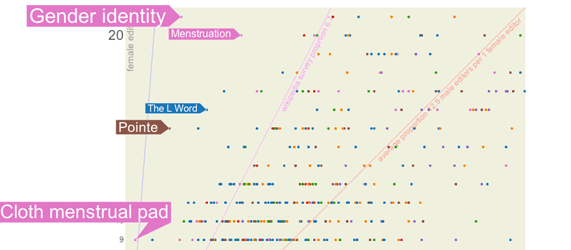Wikipedia, Your Gender Bias is Showing
For A More Civilized Age

Women of the Internet, start your editing engines. If it’s one thing we’ve learned recently from go-to Web info source Wikipedia, it’s that what the user-edited encyclopedia could use more of is you.
Researcher Santiago Oritz has developed Wikipedia Gender, “an interactive visualization that shows which articles have more male or female editors”. The graph matrix runs the spectrum of user ratio against female-to-male, with scrollover dots and a color key that help identify specific subjects. Two things immediately become clear: First, that the number of male editors far outweighs female editors (as reported by the New York Times earlier this year, women make up just 13% of total contributors). Two, that, apparently, the only subjects where the ratio almost levels out are on drastically female-body-oriented subjects like menstruation, or, for reasons that could perhaps merit their own article, gender identity. In fact, of the 3,000 articles analyzed by Ortiz, the only article that has a female majority is the one for the Cloth Menstrual Pad. Understandable, but….yikes.
Unlike the Daily Dot, however, we at TMS don’t consider Oritz’s motivation of wondering about gender stereotypes and editing to be a “second, lighter motive”. There’s nothing frivolous about looking at what posts and subjects women tend to gravitate towards editing (or, conversely, that men don’t gravitate towards). Ortiz’s findings are interesting, but could also inform an important, ongoing dialogue about identity, culturally-ingrained comfort, and user culture online. While there are larger (but still not equal) measures of female participants in entertainment, TV, and book articles, the traditionally masculine (but not actually female-absent) arenas of technology, math, and science are overwhelmingly dominated by male users. User-edited content creation is less indicative of overall interest, remember, than it is of the comfort level some users might feel participating in a particular area of knowledge, due either to cultural mores or to the behavior of other users.
As Ortiz has said of his study, “The more these biases are well-known, the more are the chances to start fixing them. And I believe that’s the way most of the people working at Wikipedia think.” Encouraging female participation is a complicated endeavor, one that requires changes inside and out. Wikipedia, and its dedicated user base, could make greater strides towards equality by more heavily moderating divisive areas of the site. But, just as important, is for women to get in there and write! A site that strives for a universally-created body of subjects needs a more representative base. The only people who can help it get there are us.
Do play around with Ortiz’s visualization, it’s very interesting.
(via The Daily Dot)
Have a tip we should know? [email protected]